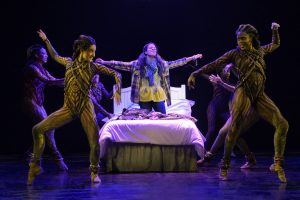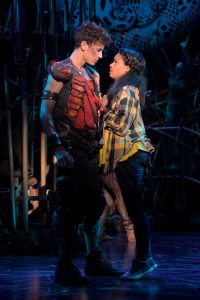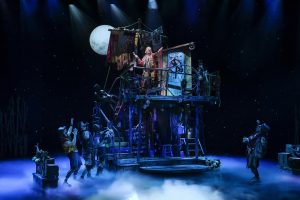‘Fly’ Needs More Help to Rise at La Jolla Playhouse
While there are an infinite variety of tweaks available to storytellers, there really are only a few plots that always work. It’s safe to say that “boy meets girl” is a better bet than the snail races.
But care must be taken to preserve and protect the plot’s essential core. Having the boy and the girl sigh and rhapsodize and pose with their passions without actually meeting is a dead end. If the idea is to tell some entirely different story, find a more appropriate plot.
At the La Jolla Playhouse right now, J. M Barrie’s evergreen tale of Peter Pan is being pounded into a pulp of prim and trendy Eco-feminism homily nailed onto the solid timbers of Victorian nursery fiction from 116 years ago.
Wendy is now the central character but she’s without her mother, her younger brothers or her floppy dog/nurse. There’s just her loving but preoccupied father to support her lonesome dreams. When Peter Pan flies in through her window, it’s not in search of his shadow, which has become just a prop. Tinker Bell, who should be a prop, is a rosy dancer hanging like a sack of potatoes from some wire above.
And that, probably, is a key to this whole unsatisfactory enterprise. It is titled Fly, but nobody does.
Barrie’s story, adapted from tales he told to the orphaned sons of two dear friends, was introduced on the London stage in 1904, staged by Dion Boucicault, one of the geniuses of the 19th Century English-speaking theatre. The play, a major hit with the title Peter Pan; or, The Boy Who Wouldn’t Grow Up, was endlessly revised by Barrie until its 1928 published edition. He also did a 1911 novel named Peter and Wendy with the same basic story. The first of many film versions was in 1924; the best-known so far is the 1953 Disney version. Stage adaptations include a Leonard Bernstein score in 1950 with Jean Arthur and Boris Karloff and the 1954 version starring Mary Martin and Cyril Richard with songs mostly by Moose Charlap and Carolyn Leigh, the version later revived frequently with Sandy Duncan or Cathy Rigby.
Most of these shows, and many others, were wise enough to check out Boucicault’s original 1904 staging for guidance. He’s the one who made Tinker Bell a flash of light (reflected from a stagehand’s mirror) with bells for a voice, featured in the play’s most legendary moment, when Tink is heroically dying and can be saved only by the audience’s belief in fairies as signified by its applause… which always comes.
(Legend has it that Barrie was nervous about the bit so Boucicault instructed the musicians in the pit to start the applause if necessary. It was never necessary. And probably never has been.)
It also was Barrie and Boucicault who began the tradition of casting an actress in the role of Peter. While there has long been a British tradition of young heroes being played by spunky girls in tights, this added a dimension to the fantasy of Peter who, alone among the Lost Boys of Neverland, would choose never to grow up. The first Peter was the director’s daughter, Nina Boucicault, but the ethereal waif Maude Adams was the one who charmed a generation and set the standard.
As for the aerial part, Fly is a literal flop. Never gets off the ground, really. The lifts are all hung along the same strip of stage, the cables are ever-present and the hooks are weighted and clunky. Once aloft, the actors mostly hang like produce on sale.
What to do? The simplest solution is to hire Flying by Foy, a Las Vegas outfit still in the family of the late Peter Foy, who followed the original London riggers of Peter Pan – Kirby’s Flying Ballet – sometime in the 1950s. The Foy people have the patented gear to solve all problems, the travelling staff to see that it works properly and lots of rules. For about $3,130 (plus hotel and per diem), your troubles are over. Otherwise, well, see the results at the Mandel Weiss Theatre these days. (There are other flying solutions, just check out the Internet, but Foy is usually the first name heard.)
It’s also possible to use some stagecraft and ingenuity. May I suggest choreography, shadow puppets, blacklight tricks, scooters on a dark stage, moveable platforms or see-saws? Plus lots of smoke?
And generations of playgoers have found that Tinker Bell works just fine as an adjustable 3 MW Diode Pump Solid-State Green Laser. Also, yes, available from Foy.
Why all the technology? Mainly because the show started it, with that title. Fly implies to me something much lighter on its feet than this. Rajiv Joseph wrote the book, mainly crediting Barrie’s novel, and Bill Sherman did the music. Kirsten Childs joined Joseph on the lyrics. They have paid attention to hip-hop and they owe a lot to Stomp, the percussive British show with all the pounding of plumbing gear. Nearly every song acts like a climax and a large, enthusiastic cast raises plenty of non-fairy dust.
The children’s literature of the Victorian Era is a whirl of phantasmagoria that dazzles audiences and readily yields rich, creamy plots with darker avenues to be explored for metaphors of all sorts. Think “Treasure Island.” Or “Alice in Wonderland,” “Winnie-the-Pooh” or the fecund “Oz” books. A trove of treasure for the psychiatrist, a purse of gold for the storyteller.
But these authors have not wisely used the resources and the reason, I’m sorry to say, seems to be a pandering to imagined popular tastes.
Thus, the central character becomes a spunky, liberated female dreamer. Peter himself is reduced to a teen heart-throb right out of a boy’s band. Tiger Lily and her fierce band of Indians disappear in favor of…trees? A whole chorus of tough-looking gymnasts in costumes worthy of a Tolkien forest, all right there in the Darling family’s nursery? (No need to protect Native Americans, I say. “Indians,” like “pirates,” were just the exotic menaces of Victorian adventure tales. And the pirates, without a supportive movement, are just the old “arrgh” product, right off the shelf.)
But it’s the Crocodile that really gets kicked. The beast, remember, who swallowed Captain Hook’s hand and pursues him, wanting more? Now the menace is a hypnotic femme therapist singing, “…let me lead you to the good.” Accompanied by those Trees.
There’s more, all tangled together but mostly just mushed into mats for marching and miscellaneous mayhem. Any sharp edges have been ground down for safety’s sake but polished wickedly for crude impact.
Director Jeffrey Seller (and his choreographers Andy Blankenbuehler and Stephanie Klemons) have energized their cast with endless rhythm and crashing songs all welded together sturdily by conductor Will Van Dyke. There’s not enough variety to single out individual numbers but it all sounds fine.
Eric Anderson steals any scene he’s in as Captain Hook, not an unusual phenomenon, and any comic leftovers are pounced on by the rank-and-file pirates, headed by Nehal Joshi. Storm Lever and Lincoln Clauss are kind of a variation on the boy-meets-girl formula, both clean-cut and winning, in their way. As Tinker Bell, Isabelle McCalla exhibits the embonpoint specified in Barrie’s novel but otherwise seems sadly unfairylike.
Anna Louizos’ set is a framework of jumbled sticks and drumheads with some carefully rickety wagons needing a lot of hauling. The assorted costumes by Paul Tazewell neither help nor hinder the project and Howell Binkley’s lighting is overwrought but sometimes stirring.
Finally, though, this is a property with a distinguished stage history which has been treated roughly enough that most of its inherent magic is obscured and indifferently replaced.
There’s a temptation to suggest that, next time, these folks should find their own story.
(Continues in UCSD’s Mandell Weiss Theatre at 7:30 p.m. Tuesdays and Wednesdays; at 8 p.m. Thursdays-Saturdays; at 7 p.m. Sundays; and at 2 p.m. Saturdays and Sundays through March 29, 2010.)

Welton Jones has been following entertainment and the arts around for years, writing about them. Thirty-five of those years were spent at the UNION-TRIBUNE, the last decade was with SANDIEGO.COM.





